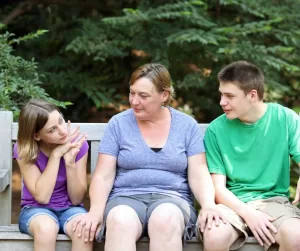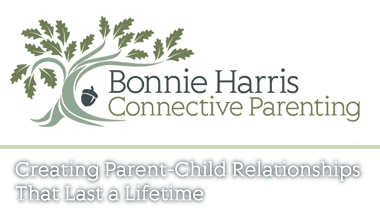 Boundaries refer to the separation of responsibilities between me and my child. Limits refer to what behaviors I am ok with and what I am not. To have appropriate limits, it is essential to establish healthy boundaries.
Boundaries refer to the separation of responsibilities between me and my child. Limits refer to what behaviors I am ok with and what I am not. To have appropriate limits, it is essential to establish healthy boundaries.
Your child’s thoughts, emotions and behavior are NOT your responsibility.
Your thoughts, emotions and behavior are your responsibility, never your child’s.
You are not responsible for your child’s happiness. You are 100% responsible for everything you say and do.
This principle of responsibility underlies the effective and successful application of any and all of your parenting. This is a strong boundary.
But do you look at your children’s behavior as a reflection of your parenting? Do you see acting out behavior as a sign of your inadequacy? Do you feel resentful when you do so much and get so little appreciation? If yes, your boundaries need some shoring up.
Healthy Boundaries
A boundary is the dividing line between me and my child (or anyone). On my side of the boundary, I know what my problems, emotions, behavior, and responsibilities are. And I do not ask my child (or anyone) to take responsibility for my problems; I do not blame my problems or emotions on anyone; I know my problems are mine.
On my child’s side of the healthy boundary are her problems, emotions, behavior, and responsibilities. With a strong boundary, I do not take them on as my own; I do not take responsibility for them; I do not try to fix them or make them go away. All of this is necessary for me to fully support and help my child in taking care of her problems and managing her emotions.
When I jump in and do anything to make him happy, not feel disappointed or sad or bored; if I put him in time out when he is having a tantrum or “talking back”, I talk to a teacher about changing the grade he got or tell him what to do to solve a problem, I am telling my child that I will take responsibility so he doesn’t have to.
 Think about it. If my child is expressing sadness, anger, disappointment, resentment, and I get upset about it and yell or blame her, I am telling her that she is responsible for making me upset. This happens because I am too uncomfortable allowing her to feel whatever she has a right to feel. If I respond with empathy and understanding of her emotions, I am allowing her to take responsibility for them and support her through them.
Think about it. If my child is expressing sadness, anger, disappointment, resentment, and I get upset about it and yell or blame her, I am telling her that she is responsible for making me upset. This happens because I am too uncomfortable allowing her to feel whatever she has a right to feel. If I respond with empathy and understanding of her emotions, I am allowing her to take responsibility for them and support her through them.
If I am responsible for my child’s happiness—but he remains angry no matter what I do—who’s fault is it? Mine. If I can’t make my child happy, then I fail. So then I feel terrible, disappointed, or resentful that my child doesn’t appreciate my efforts. It becomes about me and how I have done it wrong.
Or maybe I do make her happy and she comes to depend on me to fix her problems and give her what she wants. In none of these scenarios am I helping my child to grow and develop responsibility and resilience.
With a healthy boundary, I fully listen and support my child because it is not my job to fix her or her problems. I can be helpful because I’m not taking responsibility. When it’s my responsibility, I have to control it, I have to make sure it works out. Or I fail.
My responsibility is to help and guide my child to figure it out for herself.
 Who Owns the Problem?
Who Owns the Problem?
If it’s my problem, I own it. I am so angry about clothes left all over the floor, rather than, How can you be so messy and inconsiderate? (blame)
If it’s my child’s problem, I allow him to own it, It sounds like Henry is not being a good friend, rather than, How can he say that to you? You have to tell him he’s not being a good friend.
When you or your child has a problem, healthy boundaries you can help each other with your problems rather than blame them on each other.
I would like to come up with a plan, so your clothes get into the hamper. Do you have any ideas?
What would you like to do about Henry? What do you want him to know?
Even a very young child thrives on being offered a choice or asked what to do to feel autonomous. A teen never wants to be told what to do. When problem solving is used from the beginning, a teen is more likely to bring problems to you because they can trust that help and support is available—not direction or control or your upset.
When boundaries are strong, firm limits and natural consequences do the teaching.
Appropriate Limits
Limits establish what is and is not okay with you. They promote good relationships because you are saying what you want and don’t want.
I don’t like it when….
This behavior is not okay with me….
I will not be spoken to this way….
I am very angry about this.
Rather than –
You can’t do that.
Your behavior has to stop now.
Don’t you dare talk to me like that.
You make me so mad.
The first group takes responsibility for what I want and don’t want.
The second group blames my problems on my child in attempts to control the outcome.
Limits are necessary to create a balance in your relationships. If your spouse does or says something upsetting to you, you wouldn’t respond with, Give me your phone. I am taking it for a week. You would know there is a problem in the relationship, and you would work it out. Why is it any different with a child? Why do you think you have the right to order a child to do your bidding if you don’t want your child learning the same strategy?
Healthy boundaries are about taking responsibility for yourself and not for others.
Limits are about what behaviors I do and do not allow.
Good, long lasting relationships require both.
Related Articles:







